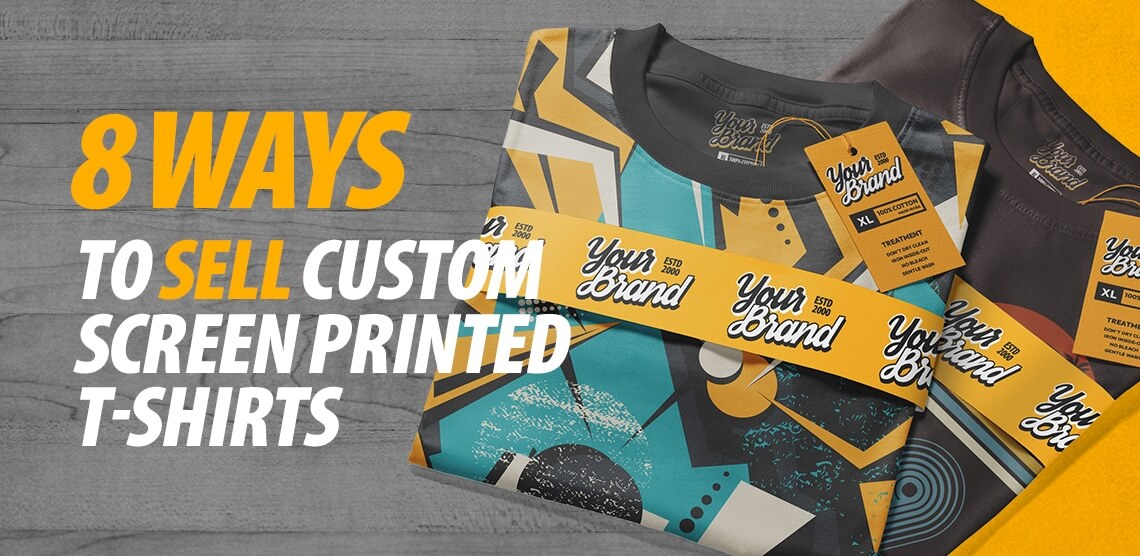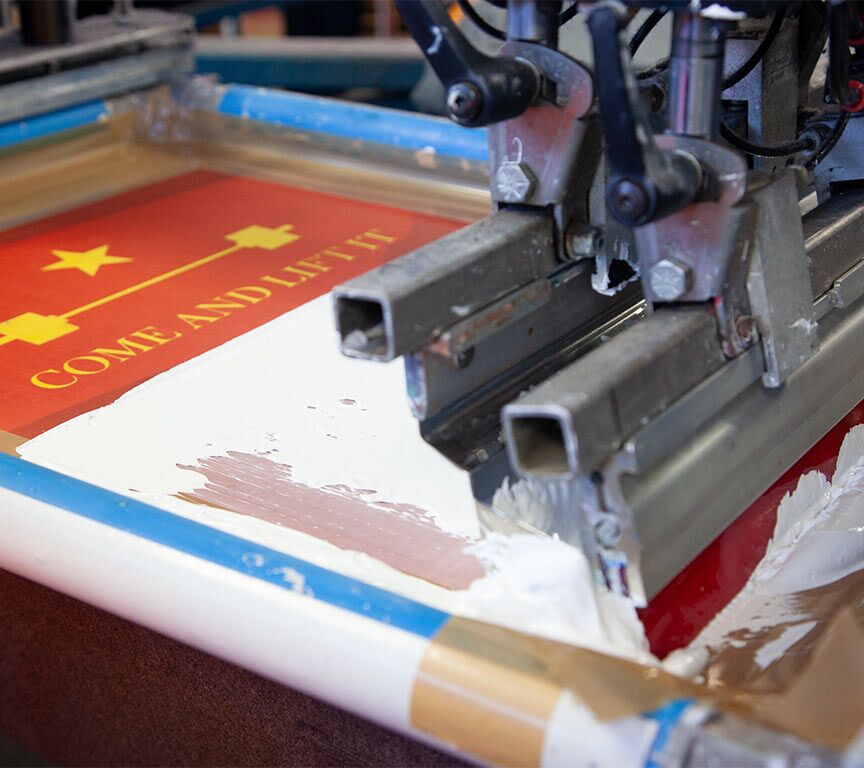High-Volume T-Shirt Printing for Schools and Organizations
High-Volume T-Shirt Printing for Schools and Organizations
Blog Article
Screen Printing Uncovered: Whatever You Required to Find Out About T-Shirt and Garment Printing Methods
Screen printing is a fascinating technique that combines art with technique, offering countless possibilities for creative thinking. All set to explore the crucial elements that make display printing an art type?
The Fundamentals of Screen Printing: How It Works
When you dive right into display printing, you'll find it's both a scientific research and an art. At its core, display printing entails creating a pattern, or screen, that permits ink to pass through only in specific locations.
Next, you'll blend your inks and prepare your printing surface area. Placement the screen over the fabric, then use a squeegee to push ink through the display onto the garment. This procedure requires precision, as you want clear, dynamic prints. After printing, you'll cure the ink with warmth, guaranteeing it follows the material and lasts via cleans. Each action is vital, and mastering them will boost your display printing skills, transforming straightforward garments right into one-of-a-kind, expressive items.
Kinds of Display Printing Techniques
Once you comprehend the essentials of display printing, it's time to check out the numerous strategies that can elevate your styles. One popular method is standard display printing, where ink is pressed through a stenciled display. This technique is excellent for vibrant, vibrant shades. Then there's water-based ink printing, which provides a softer feeling and is eco-friendly, yet it needs a various approach to healing.
Another choice is plastisol printing, known for its durability and vibrant shades, making it a preferred for several brands. Experiment with halftone printing to create slope impacts and elaborate layouts.
Necessary Equipment for Display Printing
To attain magnificent results in display printing, having the appropriate equipment is fundamental. You'll require a durable display printing frame, which holds the mesh that moves your design onto the garment. Next off, invest in top notch squeegees; these are important for using ink equally across the display.
Picking the Right Inks and Materials
When choosing inks and materials for screen printing, you need to take right into account the sort of ink that works finest for your project. Think about textile compatibility to guarantee your styles look last and terrific lengthy. Also, explore environment-friendly ink choices to make your printing procedure extra sustainable.
Sorts Of Screen Inks
Selecting the appropriate screen ink is vital for achieving dynamic, sturdy prints that meet your task's needs. There are several kinds of display inks to check out. Specialty inks, such as metal or glow-in-the-dark, can include one-of-a-kind results to your styles.

Material Compatibility Considerations
Understanding textile compatibility is important for attaining top quality screen prints, particularly because various materials respond uniquely to various inks. When selecting inks, take into consideration the fabric type-- cotton, polyester, or blends. For cotton, water-based inks work well, supplying softness and breathability. Polyester, on the various other hand, typically needs plastisol inks for far better adhesion and vivid colors. If you're printing on blends, you might require to utilize a mix of both kinds. Always check your inks on sample fabric to guarantee they stick properly and keep shade honesty. In addition, bear in mind that fabric weight and texture can impact the final end result, so picking the ideal ink and product combination is important for your project's success.
Eco-Friendly Ink Options
Green inks are becoming a preferred option for screen printers who want to minimize their environmental impact while maintaining quality. When choosing inks, take into consideration water-based inks, which are less unsafe and less complicated to tidy up contrasted to typical solvents. These inks bond well with materials, supplying lively outcomes without toxic chemicals. You may also discover eco-solvent inks that make use of fewer unpredictable organic substances (VOCs), making them a safer choice for both your health and wellness and the earth.
Additionally, search for inks made from sustainable sources, such as soy or vegetable-based choices. By choosing the ideal inks and materials, you'll not just produce magnificent styles but additionally contribute to a much more lasting printing procedure. Make the switch, and your prints will show your dedication to the setting!
Preparing Your Layout for Display Printing

Submit Format Demands
To guarantee your layout looks lively and sharp on material, you'll need to pay attention to file format needs for screen printing. Beginning with vector data like AI or EPS, as they can be scaled without losing top quality. If you use raster images, decide for high-resolution data, such as TIFF or PNG, preferably at 300 DPI. Avoid utilizing JPEGs, as they can shed clearness when resized. Make certain your design has a transparent background to avoid unwanted white edges on your prints. Maintain color settings in mind; CMYK is conventional for display printing, so transform your RGB develops appropriately - screen printing kit. By adhering to these standards, you'll set your art work up for an effective print.
Shade Separation Methods
Shade splitting up is a vital action in preparing your design for display printing, and grasping it can substantially improve your print top quality. You'll need to break your style right into individual shades, as each shade needs a separate screen during printing. Begin by recognizing all the colors in your style and create layers each. You can use software application like Adobe Photoshop or Illustrator to isolate and separate shades properly. Be particular to conserve each layer as a different file, normally in a format like TIFF or PSD. This accuracy not just ensures exact color depiction but likewise enhances the printing procedure. By taking note of shade splitting up, you'll attain vivid and specialist results in your screen-printed garments.
Resolution and Dimension
Achieving the most effective cause screen printing begins with guaranteeing your design has the right find this resolution and dimension. Preferably, your art work ought to be at the very least 300 DPI (dots per inch) for sharp, clear prints. Your last item might look unprofessional and pixelated. if you make use of lower resolution.
When it concerns dimension, think about the measurements of your print area. Layout your artwork to match the last print dimension, preferably producing it in the actual dimensions you'll be printing. In this manner, you'll avoid any type of unexpected scaling problems.
Constantly examine your style in both vector and raster styles. Vector graphics click here to read can be scaled without shedding quality, making them suitable for display printing. Preparing properly will assure your style looks outstanding on every garment!
Step-by-Step Display Printing Refine
Display printing is a vibrant procedure that permits you to develop lively styles on various surfaces. To obtain begun, you'll need a display, emulsion, and your selected ink.
Pour ink onto the display and utilize a squeegee to press the ink via the stencil onto the fabric. Lift the screen very carefully and allow the print completely dry. You've effectively display printed your design.
Tips for Effective Screen Printing Projects
While you're diving right into your screen printing tasks, keep in mind that prep work is crucial to success. Begin by collecting all your products-- inks, mops, garments, and displays. A tidy office helps avoid unwanted mistakes, so neat up prior to you begin.
Following, confirm your art work is high-resolution and properly sized for your garment. Test your screen for correct exposure and tidy it completely to prevent spots. When mixing your inks, adhere to the manufacturer's standards to attain the appropriate consistency.
Throughout printing, use even stress with your squeegee for constant results. Don't rush; take your time to validate each print satisfies your criteria. After printing, allow your garments completely dry totally prior to handling or packaging them.
Finally, constantly keep a sample of your benefit future recommendation. By doing this, you can evaluate your progress and improve your techniques in time. Satisfied printing!

Regularly Asked Concerns
How Lengthy Does It Require To Establish a Display Printing Job?
Setting up a screen printing task typically takes around thirty minutes to an hour. You'll prepare the displays, mix inks, and readjust the press. The time differs based upon intricacy and experience, so stay organized!
Can I Publish on Different Material Types Making Use Of the Very Same Technique?
Yes, you can print on various textile types using the exact same technique, however you'll require to readjust your inks and settings. Some materials soak up ink differently, so trying out warranties the very best results for each material.
What Prevail Errors to Prevent in Display Printing?
When display printing, stay clear of common blunders like utilizing the incorrect ink, disregarding proper exposure times, or avoiding pre-press checks. Always evaluate your configuration and maintain clean displays to guarantee quality outcomes each time.
Exactly How Can I Effectively Clean and Preserve My Display Printing Devices?
To properly tidy and keep your screen printing tools, you must frequently clean screens with suitable solvents, inspect squeegees for wear, and assure all devices are saved completely dry and dust-free. Consistency stops costly repair services and boosts performance.
Is Display Printing Eco-friendly Contrasted to Various Other Methods?
Display printing can be a lot more eco-friendly than various other approaches, specifically if you make use of water-based inks and eco-conscious materials. By selecting lasting supplies and practices, you reduce waste and reduce your impact on the earth.
Display Printing Uncovered: Everything You Required to Know About T-Shirt and Garment Printing Techniques
At its core, display printing involves developing a stencil, or screen, that allows ink to pass through just in particular locations. Placement the display over the material, after that use a squeegee to press ink through the display onto the garment. One popular method is standard display printing, where ink is pressed through a stenciled screen.When picking inks and products for screen printing, you require to click to investigate take right into account the type of ink that functions ideal for your task.
Report this page